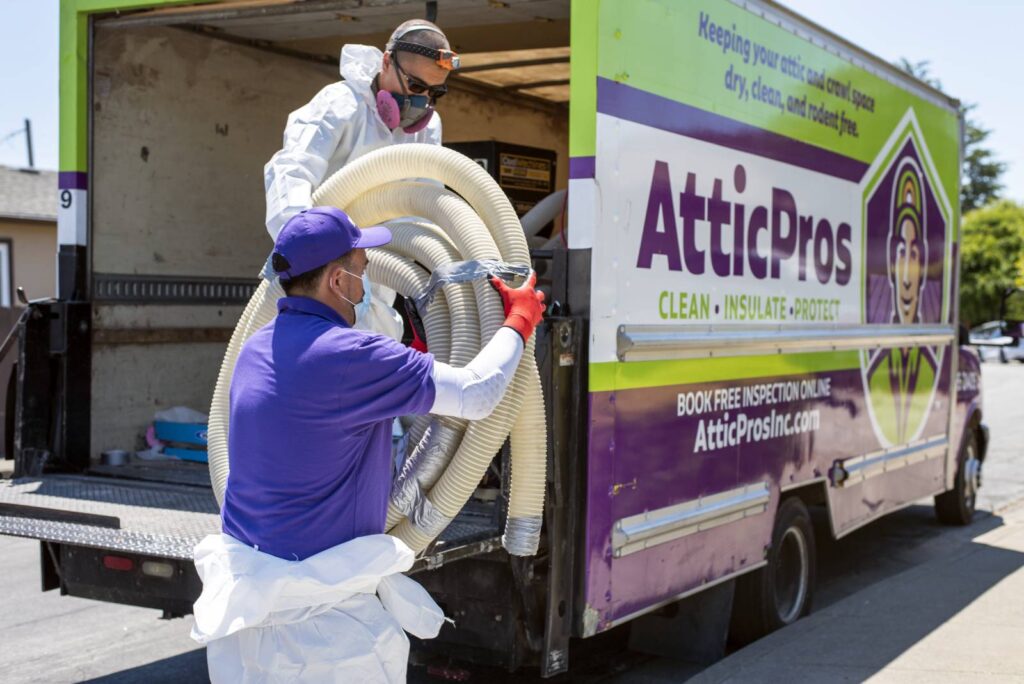Black Mold on Insulation – What Does it Mean?
Have you ventured up into your attic recently, only to discover black mold on your insulation? It’s not a pleasant sight and could cause you some concern. Keep reading to find out why your insulation is harboring black mold, what it is, and how to properly deal with it.
Why Does Insulation Turn Black?
Black insulation is not always a concern because there are solutions. However, when you are inspecting the insulation in your attic, you should always wear protective gear to be on the safe side. Wear a breathing mask, long pants, a long-sleeved shirt, and gloves before you start poking around in your attic.
When you are done inspecting, be sure to wash your clothing right away. If the black color does turn out to be black mold, you don’t want to be dragging mold spores into your living area, where they could find a new home.
Insulation can turn black for a couple of reasons, The first is that it’s simply dust and dirt that has collected on the surface over the years. The other is that you have a more serious and toxic black mold problem.
How Does Insulation Turn Black?
One of the most common ways for insulation in your attic or crawl space to turn black is through air leaks. Air flowing into your attic through leaks will carry dust that gets deposited on the insulation. Over time, a sufficiently thick layer of dust will turn your insulation a darker shade.
If there isn’t much dust, you can easily clean it up yourself. You will need to seal the air leaks to prevent dust from getting in there again. If the accumulation has been going on for years, it might be time to replace the insulation after you plug up the leaks.
In some ways, insulation that is black from dirt and not mold is a fortunate find because it can alert you to a leakage issue with your attic that you can easily fix.
The other way insulation can turn black is because of a black mold infestation. Black mold will grow when there is enough moisture in the attic to support any spores that make their way in through air leaks.
Moisture can find its way into your attic through a leaky roof but can also form through condensation. Warm, moist air leaking into the attic from the living space below will condense when it makes contact with the cool roofing material which can drip into the insulation.
Just about every type of home insulation, from cellulose to fiberglass, will act like a sponge wherever there is moisture. Even a small amount of condensation or leakage can cause big problems with mold if you don’t notice it in time.
If you check your attic regularly, you may be lucky enough to find only a small amount of insulation has black mold growing on it. In this case, you can easily remove the offending insulation, and replace it with new. Make sure you fix the source of the moisture so it can’t come back.
However, moisture can spread to other areas of the attic if left to its own devices. Once black mold takes hold, it will quickly spread to other areas of the attic wherever the insulation gets wet. When this happens, your only option is to replace it with new insulation.
You will need to scrub the attic clean to remove every trace of mold. Even a tiny amount left behind will quickly grow back, especially if you still need to resolve the leaks or moisture problems.
We highly recommend a professional attic insulation service for removing your old insulation and installing new insulation. They have the equipment, PPE, and experience to ensure it is done efficiently and safely.
Attic insulation professionals will also inspect your attic for leaks and seal them up so you won’t have any dust or mold problems in the future.
What Types of Insulation are Vulnerable to Black Mold?
Black mold must have three things to grow: biodegradable material, moisture, and air. In certain circumstances, your attic can provide all three. Unfortunately, many types of insulation are a perfect source of nutrition for mold when it gets wet, but there are a few types that will resist the spores.
Fiberglass: Spores cannot grow on the glass fibers of fiberglass insulation, but they can grow on the backing. You should also keep in mind that wet fiberglass does not work as well, and the trapped moisture can cause wood and attract pests.
Spray Foam: This material is both an insulating material and an air seal, so it’s excellent for plugging up leaks. Sufficiently thick, properly aligned spray foam insulation will resist moisture and mold spores.
Natural Material Insulation: Most types of natural material insulation like cotton, cellulose, and wood fiber insulation will harbor black mold when there is sufficient moisture available.
While there are a few insulation materials that are resistant to mold, you should always deal with a moisture problem regardless. Moisture in the attic is never a good thing. Even if you don’t get black mold, moisture trapped in the attic can soak into the wooden joists and cause wood rot.
A dry attic is also less likely to attract pests which require a source of moisture to survive. If you want to avoid rats, raccoons, and mice in the attic, make sure your attic is always dry.
When to Call the Attic Pros
Dealing with mold on your insulation and replacing it is a big dirty job. A large black mold outbreak can be tricky to rectify if you don’t have the experience or equipment. We also don’t have to tell you how cramped and difficult it is to move around up there. Don’t leave anything to chance when you find black mold on your insulation. The Attic Pros professionals will not only deal with your mold problem, but they will also find and rectify the source of the issue so the mold cannot return.

